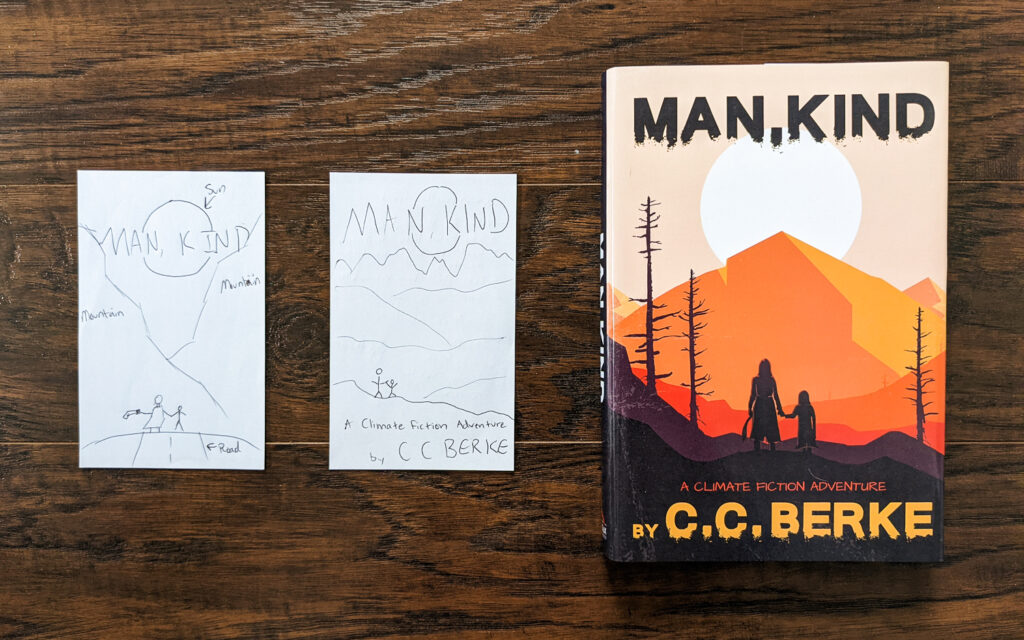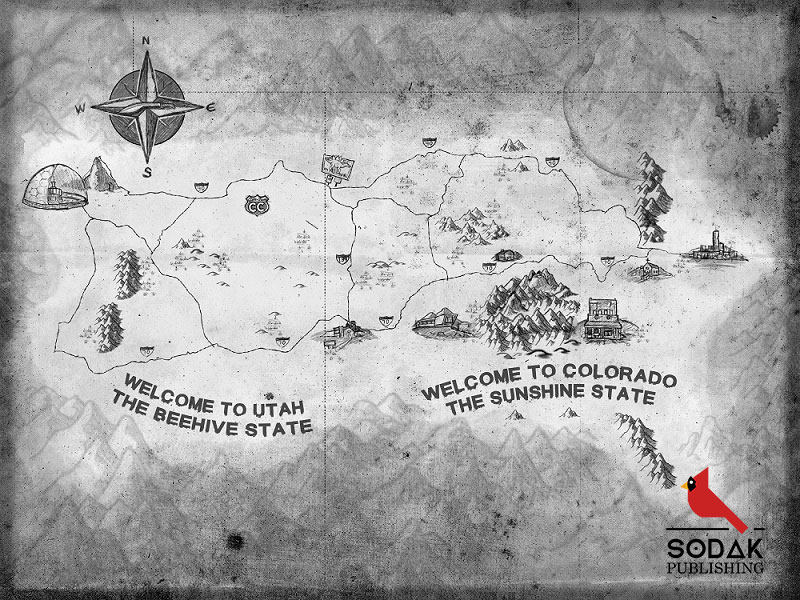What! I just spent all this time writing and editing and rewriting my manuscript and now I have to become a graphic designer, too?
Not necessarily! Believe me, I know the pressure put on Millennials and younger generations to be adept at 100 different things just to get an entry level job, but don’t kill yourself over something you might not have the skills, or time, to accomplish. Burnout is very real. Just remember that this is supposed to be the fun part. So take some deep breaths and follow the steps below to source the cover your novel deserves!
Go To The Book Store
My bet is you’ve had a book cover or two in mind since before you even wrote your first sentence. One you may have picked up on a bookshelf that gave you the idea for your story, or one that gave you the inspiration to push through and finish it. There’s probably a few out there that coaxed you into buying a book without reading anything about it! (For me this would be The Lives of the Monster Dogs by Kirstin Bakis and Hummingbird Salamander by Jeff VanderMeer.)
Although this is absolutely the energy you want to capture, do not go out and blatantly copy those covers. What I suggest is curating a group of 5 – 10 of your favorite covers for inspiration. You can search the web for popular new titles in your genre, but heading down to your favorite book store also doubles as therapy. Poke around, see what covers stand out to you, ask yourself why they stand out to you, and snap a picture if you don’t plan on buying anything this trip.
Note: Study spines and back covers as well!
And please don’t just visit Barnes & Noble. While they will have the largest number of books to look through, your local bookstores are much more likely to carry unique and/or original covers for the books you love.
Note: I personally keep an Inspiration subfolder in all of my Titles’ parent folders. This usually contains a covers, fonts, graphics, and images that keep my mind on my story.
Grab The Pen And Paper
I know, I know, sketching something is the most terrifying thought a non-artistic person can do. I am BEYOND awful at drawing, but I had to get something visualized on paper to show the artist that I reached out to. It helped me see what I wanted, and helped them understand just what the heck I was describing to them. Your artist will likely not have time to read your book, and you don’t want to wait for them to do so anyway, so YOU need to have an idea of what you want.
Besides, in the right hands, my shitty sketches turned into something I love with all my heart. (See fig. 1)

Phone A Friend
Look, the “Big 5” publishers have wads of cash they can throw at professional cover designers and then hire focus groups to vote on the design they think will sell the most copies. You don’t. But you also need to understand that your book isn’t going to be sharing a shelf with any of those “Big 5” corporate books anyways (At least not at first!). Yours will likely be for sale in the local section of local books stores and on the various print-to-order internet outlets. Those are just the facts. So why not focus your project into a locally-sourced work of art?
That’s right, contact your friends and local artists! Chances are you know someone who is making cool stuff in your community. Or at least you know someone who knows someone. Graphic designers, street artists, painters, etc…give them a call, explain your vision, and see if they can do what they do best. If you’re still at a crossroads, they probably know someone who knows someone as well!
Duh, you will have to pay them, but it will be a lot more reasonable than outsourcing and also something you both will be extremely proud of. Why not have another champion in the ring with you?
Outsourcing
If you’re still coming up short on local talent, there’s always outsourcing!
To be honest, I don’t have ANY experience with outsourcing any work. I’m famously a stubborn DIYer. And, to be frank, I am extremely fortunate to be good friends with my illustrator Brent of Brentiis Design. That being said, there are some great options out there!
Fiverr
This might be the second best route. Fiverr is filled with freelancers that are real human beings. With just a quick Fiverr search of “Book Cover,” I can see pricing anywhere from $10 to $300+. I am assuming you get what you pay for here, and there are some good designers with the “verified” stamp to look out for as well. Check it out!
99 Designs
Again, same story as Fiverr, but centered specifically around book covers. These are the experts, but they come at a premium. If you’ve got the money, and you want to spend it here, I’m sure you will be happy with the results.
Brent Plooster
Did I mention my own illustrator, Brent? He’s awesome and would be happy to discuss any illustration project with you! You can reach him at www.brentiisdesign.com.
DIY
Maybe you do have a little graphic and/or art experience under your belt and want to make your own cover. I 100% support this! The project will be completely yours in every way. There are just a few industry standards to keep in mind:
- Don’t over-complicate it! Many popular covers nowadays are extremely simple or “minimalist”. Think anything from Penguin Random House. I particularly love these minimalist designs because they can be just as impactful as full-blown scenery with character models.
- Google “Minimalist Book Covers” and you’ll see what I mean.
- Your cover will be seen on the internet before it is seen anywhere else. Make sure your title and your name are in LARGE print, make sure your fonts are easy to read, and make sure they both stand out.
- Think the little thumbnail images on Amazon or B&N.com when searching for books yourself.
- Know what size you want your book to be. The easiest way to do this is to grab your favorite books on your own shelf and measure them.
- 5″ x 8″, 5.25″ x 8.25″, and 6″ x 9″ are among the most popular sizes.
- Usually a hardcover is slightly larger than its paperback counterpart, so design the cover with the largest size in mind first.
- An eBook thumbnail is typically a different format and size. Amazon says the ideal ratio is 1.6:1 or 1600h x 1000w.
- Understand print vs. digital.
- Everything printed uses CMYK color grading
- Everything digital uses RGB color grading
- If you are using Adobe Illustrator, Photoshop, or some other similar design program, make sure you put each element on its own separate layer. This will come in handy when you have to resize later on for different cover formats, ads, banners, etc…
Note: I will talk more on how to acquire and use cover size templates in Part 4: Choosing A Printer, but it will not be a full Adobe Illustrator tutorial at this time. I may add an Adobe how-to in the future.
Free Self-Publisher Cover Designs
Amazon, Blurb, B&N Press, IngramSpark, Bookbaby, Lulu, etc. Just…don’t.
A Brief Recap Of My Experience
I reached out to an old coworker and friend of mine (Brent Plooster of Brentiis Design) who had also left his job to pursue self-employment full time. We hadn’t hung out in years, but he always posted great work on social media, so I called him up one day and explained my vision. As it turned out, a book cover was something on his bucket list and he was over the moon to help out. We agreed on a price, I sent him my sketches and ideas, and he got to work. It turned out to be even more fun and rewarding because we would hop on Zoom together and he would draw in real time while I watched and made suggestions. Overall great experience. 10/10, did partner up again.
In fact, we later decided that a map of my characters’ journey across Colorado and Utah would be a great addition to Man, Kind and leave the reader with more exciting visual content. About every reader I personally sold to said something to the amount of, “Oh my gosh, I LOVE maps!” I’m not saying you need to specifically include a map, but maybe brainstorm a way to make your interior a bit more special.
The hero’s journey…

Moving On From The Creative
Alrighty, fun’s over. You’ve spent lots of time and creative effort finishing up your manuscript and developing a cover you’re proud of. Now it’s time for the mind-numbing, meticulous, madness-inducing business and formatting side of things.
Don’t worry, I’m still here with you! Let’s take that next step together as you begin Part 4 of my Definitive Guide To Self Publishing: The Legal Stuff.

